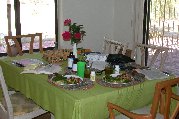 We moved the dinning room table a couple of weeks before our departure so that we sit alongside each other and both get a good look out the window facing north.
We moved the dinning room table a couple of weeks before our departure so that we sit alongside each other and both get a good look out the window facing north.
April typically is the beginning of warmer weather in central Arizona - 80s during the day with some into the 90s but nights still cool in the 50s and 60s. This year, however, most of the days (up to the point of this page creation) have not exceeded the high 70s and only 1 day, as I remember, even just made it to 90. The Phoenix area, however, is noticeably warmer, due to all the concrete and asphalt, but here in the desert about 40 miles to the south east - and about 200 feet higher - the temperatures are always milder. And the vegetation that's been planted around the house also helps provide much desired shade, though we don't have nearly the amount as our neighbor to the immediate west - but we're working on it ;>)
We were quite fortunate in that it did not get "really warm" until just before we left Arizona on May 20 for our much delayed return to Toronto. Until that last week we didn't use our air conditioner at all, just closing in midmorning the windows that had been open all night allowing us to enjoy the naturally cool air circulated with ceiling fans. Paul expressed his great relief that the Arizona summer had been late this year, since the 108F predicted the day of departure was to be the hottest yet that season.

We really do enjoy our window on the desert world from our dining room table while we eat breakfast and lunch. (Supper is typically eaten while we watch a movie, or a rare better than average TV show when such is available. See a sample of our TV tray suppers. (The cleared area that can be seen in the distance (beyond the creosote bushes and small palo verde) is on the neighbor's 3.5 acres directly north of us - they "nuked" it apparently in preparation for erecting a large arena or corral for their 3 horses, out of sight to the left in this picture. We will plant a few more trees and bushes to reduce this "unpretty" sight and the dust that may be blown our way when the horses are being exercised. The open area close to the block patio, was left that way many years ago as there were distant plans to have a swimming pool - still a nice thought, but probably not too likely.)
 We moved the dinning room table a couple of weeks before our departure so that we sit alongside each other and both get a good look out the window facing north.
We moved the dinning room table a couple of weeks before our departure so that we sit alongside each other and both get a good look out the window facing north.
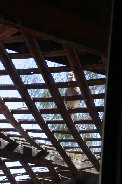
The trellis used to make this ramada overhang extension of the porch on the north side of the house provides lots of opportunities for birds of all types to try to make nests - many blow off - and for us to observe them scampering around. This is one of the many doves that frequent our yard.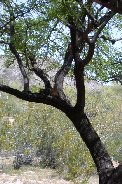 Another perches in the crook of a mesquite directly north of the dining room and master bedroom.
Another perches in the crook of a mesquite directly north of the dining room and master bedroom.
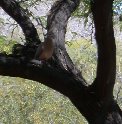 A close-up view.
A close-up view.
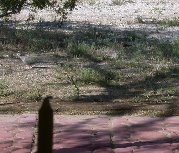
Doves - the bird to the left in photos - are plentiful on our property as well as cactus wrens, sparrows, woodpeckers, Gambil's quail, hummingbirds, and even an occasional roadrunner. However, the red bird at the right in the photo and these close-ups is not one Kitty had seen before. But then she only ate at home during the daylight hours on weekends in years past (or in a rushed state as she hurried off to work in Scottsdale) - and didn't engage in much bird watching as she does now when we are in AZ.
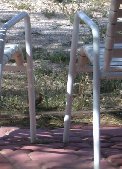
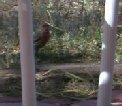
This bird, like many others visiting our yard, appears to find the native grasses (some considered weeds) quite nutritious. Others - though we did not see this red bird doing so - are seen eating seeds from the creosotes and trees.
(A few weeks after taking the photos above and many of those of birds below, we browsed through a used and new bookstore named "Changing Hands" in Tempe in the same shopping center as the Trader Joe's where we buy our green tea and chocolate. We came away with 3 identification type books on birds seen in the southwest which we've put to great use. We now know that the red bird above is a pyrrhuloxia.
The books we purchased after taking these dove photos do not explain their nesting practices.

This photo of a dove parent and 2 chicks was taken on April 26, 7 weeks and 6 days after the last photo taken of chicks from a previous family that had residency in this spot. Three days later there were no chicks to be seen; we had not witnessed the "outing" from the nest as we did in March but the post penthouse appeared to be abandoned once again.

The very next day, however, we saw these doves quite comfortably in place. We stood watching and discussing the possible identity of the occupants - a juvenile and parent from a couple days previously?

Five minutes later, as we were still standing in the living room watching, a second adult arrived with what appears to be a pine needle in its beak. What was all this about?

(5 minutes after last) We theorized that the 2 juveniles now visible, which we saw fly off during this viewing, were just not "ready" to really leave home - which was the nicest of all those around. Whether their parents were wanting to use the nesting spot again for themselves or another pair wanted it now, is speculation on our part.
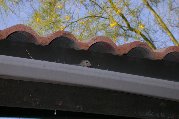
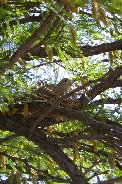
Two other dove nesting spots around the house that we caught with the camera.

The view from the north facing living room window gives us a slightly different angle from which to watch many of the animal goings-on taking place there. (*The* favorite dove nesting spot can be seen through the window.)
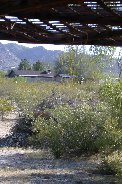
A Gambil's Quail can be seen at the top of an ever-growing brush pile at the back of our yard. Several of these fellows can be seen many times of the day scampering from the shade of one creosote bush to another. 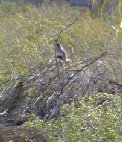 In a close-up, the distinctive head plume can just be distinguished.
In a close-up, the distinctive head plume can just be distinguished.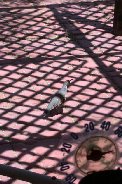
Occasionally a quail will wander closer to the house, providing a close look.

Rabbits entered the brush pile area even while the quail, still atop the brush pile, looked on in their direction.
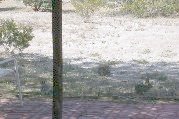
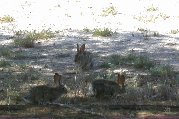
Desert rabbits - these are cottontails as opposed to jackrabbits - seem to flourish quite well even when the greenery has turned brown. One of the reasons why Kitty never wanted a fence around the property - or dogs that lived outside - is that both inhibit the free travel of many of the native animals. These rabbits would be unlikely to traipse about the yard near the house of either of our neighbors to the east or west, since both have dogs.
The most fascinating and humorous of residents on our property are the ground squirrels. They are numerous and in the past Kitty thought of them mostly as simply pests who made annoying holes in the ground. But they are definitely curious creatures to watch as they go about their business of searching for food.
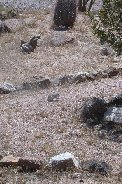

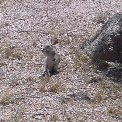
A close-up of this ground squirrel, on the path that goes from our front door around on the east side to the back, makes it clear that this animal is female and currently or recently a nursing mother.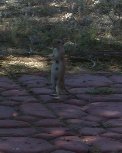 Is this similar mother ground squirrel seen in the backyard 2 days later the same animal? If so, these animals definitely get around.
Is this similar mother ground squirrel seen in the backyard 2 days later the same animal? If so, these animals definitely get around.
Ground squirrels have that name only because they make their homes in the ground. However, as can be seen by these shots, taken of the rose bush and tree on the southeast corner of the house, they are really quite comfortable moving about in the branches.
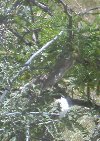
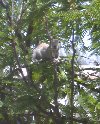
And then there are the amazing balancing acts that these fellows can do on their hind legs while perched in a tree or bush, as shown below.

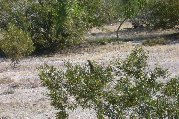
Most of the ground squirrel-watching we do is in our backyard since it is what is viewable when we are eating in the dinning room.
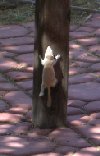
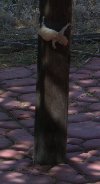
This fellow decided that there was no potential in climbing the post that supports our patio overhang. But then that's what kids have to learn, and this was one of several juveniles we were watching.
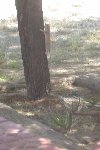
Now this climb has more potential.
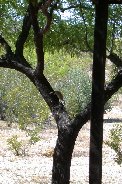
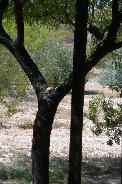
Scampering up and down trees is no different to these ground squirrels than over the hillocks of our yard.

Now what these 2 fellows at the left - or the one in the next photo - are looking at is a mystery to us. But we have witnessed by way of binoculars that they communicate with high pitched squeaks, most often while in this position.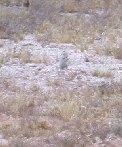
Another series of ground squirrel shots - of the same animal - taken within 6 minutes as it busied itself well within range of our dining room window in a late mid-May afternoon.
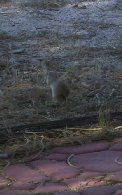
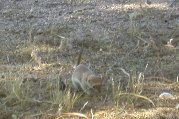
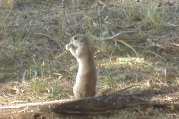
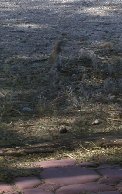

In a close-up of this last shot an unusual bull's eye-like marking could be seen on the right hip of the ground squirrel - we wondered if it there were some type of ground squirrel population study taking place, though this was the only animal we saw with this mark.
We've noticed that most activities by individuals of one species are totally ignored by a those of a different species. These shots of rabbits and a ground squirrel in close proximity are examples of daily occurences seen from our dining room window.
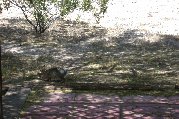
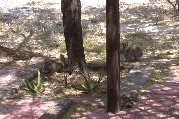
Occasionally the actions just can't be totally ignored as can be seen when the ground squirrel practically runs right under the nose of a nearby rabbit.


But the interactions between animals of the same species are quite interesting, sometimes surprising, and often amusing. So far Kitty has not been successful in having her camera at the ready to capture the fast moving antics of ground squirrels in twos and threes, but she will try again on future trips. The shots of two rabbits had more action before and between them then our digital camera could pick up, but the retelling is still interesting.
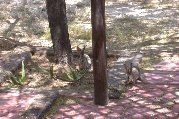
Kitty found it amusing that the rabbit on the left appeared to be looking straight at us looking at it.
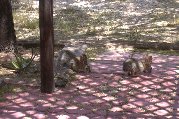
Some sort of action looked imminent as the larger rabbit approached the smaller which was in the process of moving.
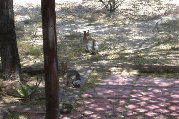
Within the 4 seconds between the last shot and this one, the larger rabbit originally on left had charged the one on right which avoided collision by jumping straight up in the air. The larger rabbit turned and ran out to the open; the smaller one staying near the tree. Kitty's camera just didn't respond fast enough in single-shot mode to capture the action.
Later that same day while on two separate trips back in the kitchen, Kitty noted that two rabbits (? the same as earlier?) were again on the patio. Patiently waiting and though trying to be quick with the finger, again she only got shots of the jumping rabbit upon landing, while the charging rabbit had actually moved out of the picture entirely. We'll definitely be looking for more of this activity next stay since we wonder how widespread it is.

Charging rabbit has run off to the left.
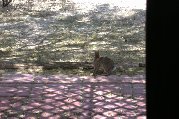
This time charger continued off to the right in direction landing rabbit appears to be looking.
Please meet "Iggy", the only animal we know as an individual. We haven't acquired a reptile identification book, so we don't know what type of lizard he is, but he is definitely quite regal in appearance and behavior.
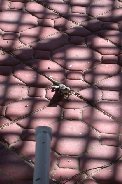
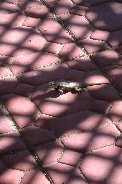
He's very "cooperative" in that he poses for long periods allowing us to watch him closely through the window with our binoculars for closeup inspection of his markings. Note the black "bib" on his upper chest that extends to his shoulders.
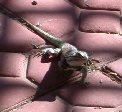
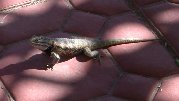
And he has a certain "Yoda" look about him - a kind of wise knowingness. We really enjoy watching him.
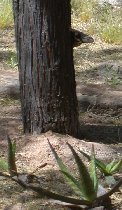
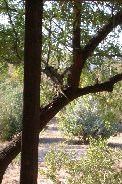
Iggy spent lots of time in this mesquite directly in back of our house, waiting patiently for a meal. We never saw him catch anything, but he didn't look malnourished.
We've seen a few snakes on the property since the days have been consistently warmer than the low 70s, although none were rattlesnakes. Lacking a snake identification book - the next purchase from the book store - we can not say what this fellow is that crawled across our patio in the early afternoon of May 8th.

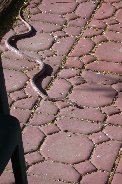
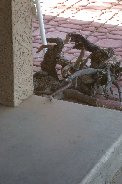
This third shot was taken by Kitty just after she exited from the back door on to the covered porch. It was at this point that the snake realized he was being "stalked".
He then did a 90 degree turn and headed away.
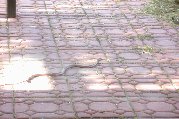
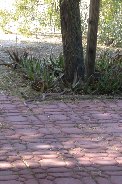
Across the patio and into the aloe vera surrounding the desert willow, he moved with both us following. Off the patio, he scurried towards this near creosote bush, beyond it to a wash and up the other, finally losing himself in the dead branches at the base of another creosote. The entire series of snake photos covered 3 minutes and 37 seconds.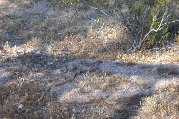

5/23/10 Update We never have purchased a US Southwest reptile book for yard critter identification, but in mid-May 2010 Jack reported to us (in Ontario at the time) seeing an approximately 5 foot snake on the east side of our house near the large palo verde that, after checking online (http://www.wildlifenorthamerica.com/Reptile/Sonoran-Gopher-Snake/Pituophis/catenifer-affinis.html), he tentatively identified as a Sonoran Gopher Snake.
 Kitty did some brightness and contrast adjusting of an old (raw) photo from above and the three look very similar according to Jack. We agree that the markings in the Wildlife of No. America site photo and this one from May 2003 are very similar. Now at least there is tentative identification of the type snake from our 2003 sighting. If anyone has more info as to type of snake, we'd like to hear it.
Kitty did some brightness and contrast adjusting of an old (raw) photo from above and the three look very similar according to Jack. We agree that the markings in the Wildlife of No. America site photo and this one from May 2003 are very similar. Now at least there is tentative identification of the type snake from our 2003 sighting. If anyone has more info as to type of snake, we'd like to hear it.
Immediately after snapping this photo of Iggy basking in the sun, Kitty spied another critter - a snake type we hadn't seen before. It was only after taking the following one that she realized that she had caught the snake in the first shot too.
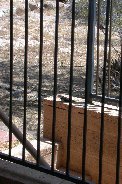
If you can't locate the "associate", check this closeup.

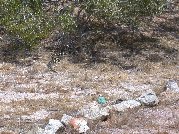
And then the snake hightails it to cover. We'll try to identify this snake once we finally acquire a book. 7/18/03 Update A MoreLife friend suggested that from the information at the Arizona Sonora Desert Muserum website that this may be a common kingsnake. This same site shows a drawing of a spiny lizard which looks very much like Iggy. Thanks, Max!
Hummingbirds are a delightful favorite visitor to our property; the sound and blur of their whirring wings are often a challenge to ear and eye. They hover making good use of the many flowering plants which were purposely chosen for their attraction of these birds. See if you can find the hummingbird in each of the full shots below.

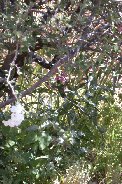
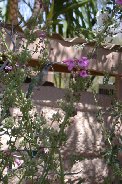
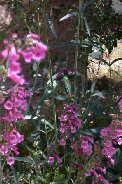
For a better look at these beautiful little birds, here are close-ups of each of the shots above.

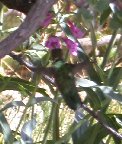

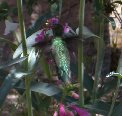
We frequently take walks through the property assessing the work we have completed and discussing what projects we think would be beneficial for the future. And of course just admiring the unique beauty of the desert plants both native and imported is a pleasure.
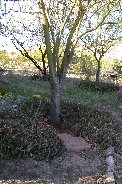
This palo verde near the southeast corner of the house was highly "infested" with aloe vera plants. As beautiful as these are when they bloom, too many we are sure have caused somewhat stunted growth in the several trees where they are prolific. This was done also for the 2 trees beyond.
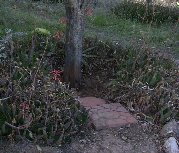
We significantly dug the aloe vera away from the trunk and made sure that the drip water emitters are working well. Yearly pruning back of these succulents will be necessary but retaining some of them also keeps the hummingbirds around.
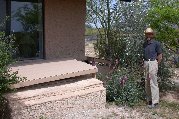
The completed window well skylight covers are proudly displayed here. So far they are working exactly as planned - the basement office is pleasantly cool without the strong AZ sun after March. We look forward to seeing the difference when we make short stays during the really hot periods.
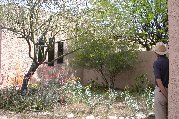
This little oasis off the master bathroom has benefitted from the earlier pruning of the cassia in front of the wall, the mesquite on the other side, and the palo verde to the left, which also received aloe vera thinning. 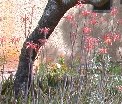 Brittle Bush are still displaying yellow blooms and some orange trumpet-shaped flowers of the Humming-Bird Bush are visible on either side of the cassia and beyond the aloe vera surrounding the palo verde.
Brittle Bush are still displaying yellow blooms and some orange trumpet-shaped flowers of the Humming-Bird Bush are visible on either side of the cassia and beyond the aloe vera surrounding the palo verde.
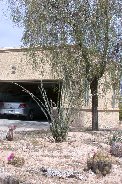
This ocotillo off the southwest corner of the house had us worried for several weeks that it had succumbed to lack of water - 2002 was a very dry year. Ocotillos though native to the area, do require occasional watering in dry periods when they have been transplanted, as this one was. 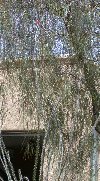 The late appearance of leaves on the stalks and finally the flame colored and shaped flowers at the tips assured us that all was well. The winter rains and our two doses of vitamin B1 in supplemental water appear to have made a difference. We will be watching this plant more carefully; but another near the front steps was not so fortunate and will be replaced. Likely we will obtain a few more to grace the property with their regal but mysterious appearance.
The late appearance of leaves on the stalks and finally the flame colored and shaped flowers at the tips assured us that all was well. The winter rains and our two doses of vitamin B1 in supplemental water appear to have made a difference. We will be watching this plant more carefully; but another near the front steps was not so fortunate and will be replaced. Likely we will obtain a few more to grace the property with their regal but mysterious appearance.
One variety of yucca on our property produces a very regal flower stalk over several weeks. The white bell shaped flowers usually stay open for at least a couple of weeks, but the petals on ours started to drop almost as soon as they all opened. Kitty theorizes that the drip irrigated water to the plant was too much (after being corrected from "under-delivery") and the stalk became very heavy - we actually had to tie it to the wrought iron railing to keep it upright. Consequently, the flowers were damaged by the short time the stalk was bent and the petals were dropped early. We reduced the flow as soon as we realized what was taking place.

Late one afternoon in mid-April, within a couple days of noticing the flower stalk.
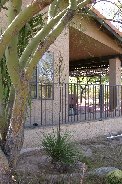

Nine days later the stalk had reached full height and the flowers began to open.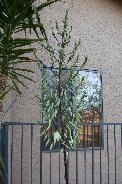 Six days later, the blossoms have only made this much progress.
Six days later, the blossoms have only made this much progress.
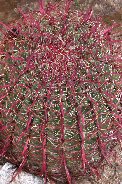
When fishhook barrel cactus get wet, the fish hooks are a brilliant red. Note the red buds, beneath the fish hooks, that will produce the blooms seen in a few weeks.
Note the red buds, beneath the fish hooks, that will produce the blooms seen in a few weeks.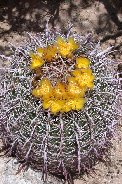
Two and a half weeks later the same barrel cactus is in bloom.
The roses along the front property line are lovely in the peak of their blooming.
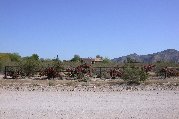
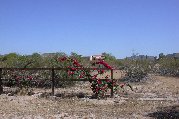
The white speck in distance at front of house is Paul. Notice the soaring eagle in 2nd picture.
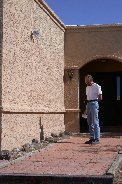
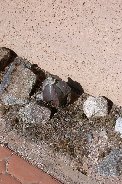
Paul noticed that the Bishop's Hat cactus was looking shriveled at the base - something Kitty does not remember from years past. It had put out 3 series of blooms while we were in residence in Arizona. Hopefully this lovely plant was just a bit shy of water and it is not nearing the end of its lifetime. We'll be watching it carefully on our next stay.
 |
 |